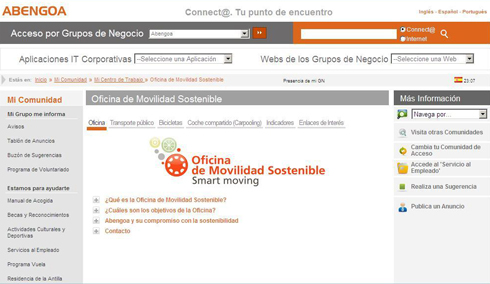 Abengoa
Abengoa
Annual Report 2010
- Corporate Social Responsibility Report
- Abengoa and its people
- Occupational Health and Safety
Occupational Risk Prevention Policy
Abengoa’s occupational risk prevention policy abides by the different occupational health and safety regulations in force in the countries in which the company operates, while seeking the integration of occupational risk prevention into company strategy through information and training.
Occupational Health and Safety Management Objectives
Fulfillment of the objectives set throughout the year within the companies, the integration and participation of workers in the execution of prevention activities, follow-up and control of the system by management, and the advice received by the company in prevention issues ensure implementation at Abengoa of an occupational risk prevention culture that has a significant impact on reducing work-related accidents and illnesses and on the continuous improvement of safety conditions in the workplace.
In accordance with prevention policy and the Common Management Norms, committees on prevention have been set up at all group companies to be responsible for monitoring and control of the system. These committees comprise company management, individuals in charge of each area, and the prevention service technicians.
Data on Work-Related Incidents
Work-related accident rates are remarkably low at Abengoa in comparison with data from similar sectors and taking into account the nature of the company’s activities. Thus, the number of accidents in 2010 totaled 26.69 (number of accidents entailing leave for every one thousand workers), and a serious accident rate of 0.28 (number of lost working days for every one thousand working hours).
The following are data from 2010:
- The total percentage of absenteeism at Abengoa (sanctions, illnesses, accidents, and justified and unjustified leaves of absence) totaled 2.50 %.
- Absenteeism deriving from common illness totaled 1.31 %, and the total for labor-related accidents was 0.21 %.
By geographical areas, the absentee rate is as follows:
Europe (Spain), 2.21 %; Europe (rest), 5.08 %; Asia, 0.85 %; Latin America, 2.74 %; North America, 0.53 %;Oceania, 7.74 % and Africa, 3.65 %.
The number of work-related accidents leading to authorized medical leave over one day totaled 837, of which 77 occurred during commutes to and from work. These accidents entailed 15,948 lost working days, of which 1,714 are attributed to in itinere accidents.
Three work-related accidents resulting in fatality occurred in 2010, due to cardio-respiratory arrest, falls from an electrical tower and shaft, and chest trauma.Por áreas geográficas, el porcentaje de absentismo es el siguiente:
Occupational Health and Safety Training, ongoing Improvement of the Occupational Risk Prevention System
Involvement and commitment of all employees to ongoing improvement of the prevention system at each Abengoa company continue to constitute the cornerstones to the management system.
In order to verify the safety conditions under which the activities of the work centers and worksites are carried out, visits were conducted to assess occupational health and safety conditions. Based on deficiencies and anomalies observed, the corresponding Troubleshooting Report (TSR) and Improvement Action (IA) systems were generated.
In accordance with defined goals and programs, in 2010 the number of visits made to companies and organizational units totaled 2,387, including audits, inspections, and measurements. Subsequently, depending on the cases of non-conformity detected and the recommendations issued, the corresponding TSR and IA were implemented, totaling around 2,783 TSR and 1,546 IA.
In 2010, Risk Prevention sessions were held in Spain and Brazil for managers. The purpose of these sessions is to raise awareness and disseminate company culture with respect to occupational risk prevention on all levels. For the company, combating work-related stress and preventing other problems that may affect employees as a result of their activity constitutes a priority and source of concern and therefore the company strives to prevent and mitigate these problems through, among other initiatives, training programs and informational talks.
Based on the different pathologies detected among the staff, lectures and information sessions were held on acute respiratory disease, parasitosis, high cholesterol, high blood pressure, HIV among others. In addition, workshops were organized to raise personnel awareness of the consequences that emotional and mental stress brought on by different factors (work, family-related, etc.) can have on their health.

OHSAS 18001-Certification of Prevention Models
Abengoa’s Common Management Norms establish, as a strategic objective for all companies, the implementation and certification of prevention management models in accordance with the OHSAS 18001:2007 Standard.
At present the number of certified companies is 79 of a total of 116, which represents 84.22 %.
Occupational Safety-Related Contractor Supplier Requirements
In accordance with the company’s internal norms, companies evaluate compliance by contractors in the area of Occupational Risk Prevention. These internal norms require that suppliers and contractors sign up to Abengoa’s Social Responsibility Code, which expressly specifies occupational health and safety conditions for all employees.

Gold Seal Award for European Excellence (+500) from the European Foundation for Quality Management (EFQM)
Abengoa’s Human Resource function (GIRH) was awarded the Gold Seal for European Excellence (+500) from the European Foundation for Quality Management, thereby becoming the first company to earn this seal in the human resource area and joining the exclusive group of 35 companies in Spain to have earned this recognition. This international endorsement is awarded by the Club of Excellence in Management to entities and organizations that apply management principles based on quality and excellence as a strategy for ongoing improvement.
GIRH was conceived in 2002 as a product of the trajectory, expertise and experience already in existence at each one of the Human Resource Departments throughout the range of Abengoa companies.
Since its inception, GIRH managers deemed it essential to align the company’s organizational structure with work and task organization, and this led to the adoption of a process-based model to enable fulfillment of the strategic plan. Efforts were also dedicated to standardizing company processes to obtain:
- Quality Management System, certified by AENOR in 2004 in accordance with ISO 9001:2000 under company registry number ER-1129/2004.
- Environmental Management System, certified by AENOR in 2005 in accordance with ISO 14001:2004 under company registry number GA-2005/0316,
- Occupational Risk Prevention System, initially certified by TUV in 2004, under registry number 35117008.05, in accordance with OHSAS 18001:1999, and by AENOR at the end of 2007, under registry number SST-0047/2008. The results of the mandatory audits conducted in accordance with Law 31/1995 and 54/2003 have been satisfactory throughout this period of time.
- As part of Abengoa, GIRH employs the Joint Prevention Service (JPS) as an organizational prevention method pursuant to Article 31 of Law 31/1995 pertaining to Risk Prevention. The JPS is made up of advanced ORP technicians specialized in occupational safety, industrial health, ergonomics, and applied psycho-sociology. The occupational medicine area is supported by collaboration from the occupational accident mutual insurance company, with which health monitoring has been arranged.
- Related Social Responsibility, SA8000:2001, certified in 2009 under registry number S1040-ES, with certification being renewed recently in 2010.
The European Excellence model, moreover, implies a global approach to business management aimed at fully meeting the needs and expectations of all stakeholders in a balanced manner, and increasing the company’s competitiveness in the medium and long term. It also enables individual and integrated assessment to be conducted in order to gain a global overview of the company.

Managerial Intercommunication Program
For Abengoa, commitment is the key to achieving excellence in performance and obtaining the best results.
Therefore, the Managerial Intercommunication Program (MIP) was implemented in 2010. The primary objective of this program is to ascertain workers’ perceptions of their professional career and development through questionnaires and interviews. The aim is thus to make the most of participants’ abilities and talents by finding the best place for them within Abengoa. Knowing their concerns, expectations, commitments and motivations contributes to direct and personalized management of their professional careers, and is realized, depending on each case, through the application of individualized solutions and plans.
MIP participants were addressed in a personalized manner by company management, and in some cases through the Human Resource Department. A variety of individual and group action plans were also drawn up.

Online Instruction Progress: Campus Abengoa
Campus Abengoa, an online training and management platform, has been consolidated to become the key tool for applying the company’s training model.
Since the initiative was launched in 2007, there has been a remarkable progression in online training. 2009 saw an increase of 57 % with respect to 2008, and this year there was an even higher progression, placing the company above the average of major Spanish companies in this area.
Online instruction focuses primarily on corporate training and risk prevention, two essential underpinnings of the company’s training model.
The company has therefore designed its own major catalog of extensive contents, including, among others, courses on finance, social responsibility, climate change, Common Management Systems, occupational risk prevention, and the use of corporate applications.
Employees highly value being able to manage their own time devoted to training, which has led to very positive overall satisfaction throughout the company.
Internal Communication
Communication is a key component of Abengoa’s philosophy. For the company, external communication and internal communication constitute a strategic tool for meeting objectives and in fostering fluid, straightforward and direct dialog with all of its stakeholders.
Effective internal communication can help to involve all employees in fulfilling corporate mission and meeting company objectives, while at the same time fostering integration and cohesion among the entire staff from a professional and personal standpoint.
Noteworthy among the company’s internal communication channels and tools made available to its employees to carry out and promote multidirectional communication are the following:
- Connect@, the corporate intranet, a platform offering its users up-close and local personalized information on company and department activity; as well as the latest news from national and international media outlets.
- The Corporate Identity Manual, which outlines the main guidelines for protecting company image.
- The Style Guide, a manual containing the main guidelines for proper text preparation, basic grammatical and lexical rules for proper usage of Spanish, specific spelling recommendations and a brief compendium of common doubts aimed at helping all employees to contribute to clear, proper and transparent communication.
- The Welcome and Integration Manual for welcoming new employees, facilitating their adaptation and offering them a general overview of company activities, structure and internal regime.
- The Abengoa Magazine, a bimonthly corporate publication in Spanish and English, containing sections on each one of the business units, corporate activities, and news items related to innovation, and other news of interest to the company. This bulletin, which is published thanks to employee collaboration, is distributed in print form to the work centers, suppliers and customers, and other stakeholders, and is also available in digital format via Connect@, as well as the Abengoa Web site.
- The Abengoa Web site, the company’s global communication tool. This is where the company transmits information related to businesses and activities in a clear and transparent manner to all of its stakeholders.
- The Abengoa blog, a virtual corporate platform through which the company offers its vision and perspective on themes involving sustainable development, climate change and environmental conservation, facilitating close, open and fluid dialog with all of the company’s stakeholders.
Campus Palmas Altas, Corporate Headquarters
As a result of the relocation at the end of 2009 to Campus Palmas Altas (CPA), the new Abengoa corporate headquarters in Seville, a specific communication program was launched and implemented over the course of 2010. The aim of the initiative was to provide the 3,000-plus employees who moved to the new facilities information on the new business complex: location, distribution, services, etc.
Worthy of special mention among the initiatives carried out under the communication program are the following:
- Creation of the Campus Palmas Altas Community through Connect@. A new section includes the following segments: Sustainable Mobility Office, Food Court, Air Conditioning, Daycare Centers, News and Calendar, in addition to the other common segments in place at the other worksites: Notices, Bulletin Board, and Suggestion Box.
Each one of the sections offers employees practical CPA information, including the latest news, services available, etc. Thus, through the Sustainable Mobility Office, conceived to promote, implement, manage and coordinate initiatives geared towards achieving more sustainable mobility at CPA, users can check information on company bus service routes and schedules; as well as other sustainable transportation alternatives for commuting to and from work, including bicycle use, carpooling, in addition to further information on efficient driving courses, demonstrations and promotions involving bike and conventional and electric motorcycle sale and rental, etc.
The Food Court section includes information on restaurant service: restaurant hours, weekly menu options, nutritional information on the different food choices, a camera link to see restaurant occupancy rate, recommendations and advice for leading a healthy lifestyle, location and availability of vending machines, etc.
The Daycare section includes useful data and information on the facilities for parents whose children between the ages of three months and three years of age make use of this service: rules of operation, ideology, activities, schedules, installations, etc.
The Notices section also keeps all CPA users up to date on the latest news, changes, etc. related to day-to-day events at corporate headquarters.
- Creation of the Campus Palmas Altas Information Bulletin. An information bulletin was designed as a supplementary channel for disseminating and communicating the latest news at CPA. In newsletter format, this weekly bulletin is sent out by email to all employees located at corporate headquarters. Bulletins include messages related to the employee flexible compensation plan, new corporate applications available for BlackBerry use; changes to Abengoa bus routes; updates on food court schedules and menu options, etc.

